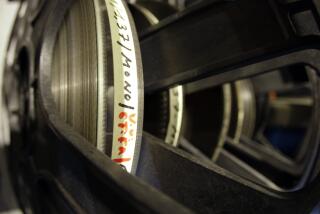Subtitle Not Spoken Here : The Valley has only one theater for ‘art films.’ But is that cause or effect?
- Share via
“Cinema Paradiso” won an Academy Award for best foreign film, but that didn’t carry much weight in Tarzana. “La Femme Nikita” was France’s top-grossing film for 1990, but you had to wait until the spring of 1991 to see it in Encino.
While multiplex theaters from Woodland Hills to Universal City continually flicker with the likes of Arnold Schwarzenegger and Mel Gibson, less than a handful of San Fernando Valley screens are devoted to foreign films and small-budget intellectual movies that compose the so-called “art film” category.
Only one cinema--the Laemmle Theater in Encino--regularly schedules such fare. And that chain usually premieres art films in Beverly Hills and West Los Angeles for six to eight weeks before their opening on this side of Mulholland Drive.
“There are probably Valley residents who wonder if a particular film is going to make it out there,” said Greg Laemmle, assistant to the president of the chain. “There have been films that didn’t.”
Last year, the movie that won the National Society of Film Critic’s award for best picture, “Life Is Sweet,” never made it to the Valley. Nor did “The Double Life of Veronique,” which was nominated as best foreign film by the Golden Globe Awards.
While the dearth of art films in the Valley is evident, the reasons for this shortcoming are not. The business of distributing and showing films is complex, involving a myriad of relationships between producers, distributors and theater owners. Within the industry, nearly everyone agrees that Valley audiences haven’t exactly clamored for art films, but that’s the only thing they agree on.
Distributors insist that there isn’t a big art-film audience here because there’s only one art house.
“A lot of people are terrified of going out on a Saturday night and having to read subtitles. But it’s the same as acquiring a taste for caviar,” said Paul Cohen, who has distributed such movies as “My Brilliant Career” and “Caligula” through Aries Film Releasing. “If you can get the owners to devote a screen or two to an art film, the audiences will support these films.”
Conversely, some studio executives and theater owners argue that there’s only one art house in the Valley because there isn’t a large audience.
“When you think of the Valley, you think of suburbia,” said Tom Sherak, an executive vice president at 20th Century Fox. “That doesn’t mean there aren’t people in Sherman Oaks who want to see art movies, but it’s nothing for them to get into the car and drive to Santa Monica. The population for art movies is denser on the Westside.”
The proof, he said, is in the pudding.
“Theaters are in the business of making money. I don’t see anyone running to Universal City to build a 14-screen art house.”
Even Laemmle feels compelled to agree. “The Valley is a tough sell. We’re never sure what film will work out there,” he said. “The major chains--United Artists and General Cinema and Pacific--they have plenty of big Hollywood films available and there’s no reason for them to be going after subtitled films.”
So the city’s best-known art houses--such as the Laemmle Music Hall, the Cineplex Beverly Center and Samuel Goldwyn’s Nuart--are in Beverly Hills or on the Westside. No matter the film, these theaters can expect a certain number of ticket sales from their loyal following.
“If you open at the Music Hall, people know what kind of movie they’re going to see,” Cohen said. “If you put the same film somewhere else, you have to spend more in ads and do more publicity to let people know what it is.”
Art film distributors and theater owners, working without the benefit of million-dollar advertising budgets, put out flyers and mailings and beg critics for reviews.
“As an exhibitor, you have to cultivate an audience, you’ve got to put a little extra effort into it,” said Mike Barker, co-president of Sony Classics, which distributes art films. “I’m not sure the (big chains) do that or want to do that.”
Perhaps the most frequent method of cultivation is “platforming.” A theater chain like Laemmle will open a film at a single theater and let it run for a month or more, hoping to generate word of mouth. Once a buzz gets started, the theater will show the film at other locations.
If the exhibitor opens in too many theaters at once, the initial audience is split several ways and none of the theaters can afford to keep the movie running long enough to get people talking.
Thus, Laemmle will open a film in Beverly Hills or the Westside, where they’re more confident of attracting strong crowds, and wait up to six weeks before showing it in Encino.
The Cineplex Odeon in Universal City, however, rarely offers the art movies that show at its Cineplex Beverly Center. On a recent week, for example, the Beverly Center offered such diverse selections as Jim Jarmusch’s “Night on Earth” and “The Waterdance.” The Universal City 18, meanwhile, showed “Batman Returns” on nine screens along with other mainstream films such as “Patriot Games” and “Sister Act.”
“It’s the studios,” a Cineplex Odeon spokesman said. “That’s what they want played there.”
The reason, again, is ticket sales. A single-screen theater, for example, will seat 700 people per showing. Multiplexes tend to have fewer seats for each screen. So, a studio will ask a multiplex to show the same movie on several screens to make up the difference. If the multiplex refuses, the studio might threaten to distribute the film to another nearby theater.
“The studios have an eye on where the market is for a type of film,” said Paul Marsh, a media and entertainment analyst for Kemper Securities Group. “The theaters know who lives in their area and what the collective tastes are. That’s good business.”
That argument returns to the circular question: Does the Valley have too few art film fans or too few art houses?
“Is there ever enough of anything?” Sherak asked.
The situation, however, may be improving for Valley filmgoers. “The Player,” a limited-release film, has shown in several area theaters. After “Mediterraneo” won an Academy Award for best foreign film in March, Laemmle decided to show the Italian film in Encino soon after it opened in Beverly Hills. The movie did good business at both locations. Laemmle is also negotiating to enlarge its Valley theater from three screens to five.
“The film business is cyclical,” Cohen said. “If it’s not happening today, you’ll see it soon. Right now we’re getting a whole new body of visionary European filmmakers. People may chance taking a peek.”
More to Read
Only good movies
Get the Indie Focus newsletter, Mark Olsen's weekly guide to the world of cinema.
You may occasionally receive promotional content from the Los Angeles Times.










